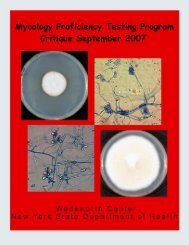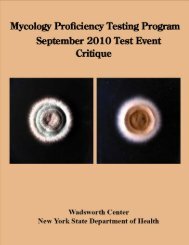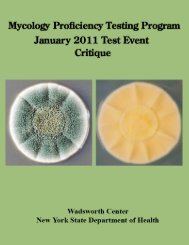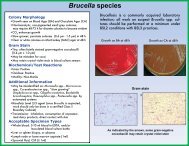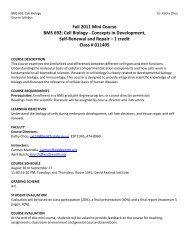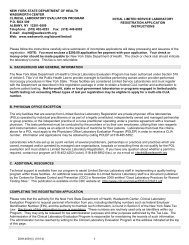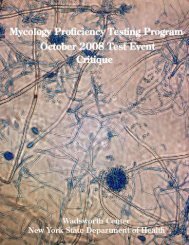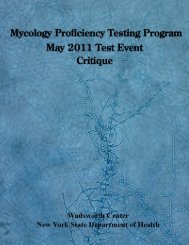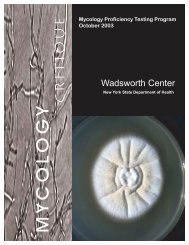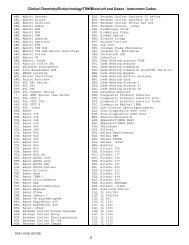September 2009 - Wadsworth Center
September 2009 - Wadsworth Center
September 2009 - Wadsworth Center
- No tags were found...
Create successful ePaper yourself
Turn your PDF publications into a flip-book with our unique Google optimized e-Paper software.
YEAST DESCRIPTIONSY-1 Candida albicansSource: Blood / Urine / TissueScoring:No. LaboratoriesReferee Laboratories with correct ID: 9Laboratories with correct ID: 46Laboratories with incorrect ID: 6(Candida rugosa) (3)(Candida dubliniensis) (2)(Candida parapsilosis) (1)Clinical Significance: Candida albicans is the most common cause of candidiasis. It is ubiquitous inhumans who probably encounter it initially during passage through the birth canal. The serious infectionsare generally seen in immunocompromised patients.Ecology: C. albicans is found as a commensal on humans and a number of other mammals. Also foundon leaves, flowers, water, and soil.Laboratory Diagnosis:1. Culture – On Sabouraud’s dextrose agar at 25°C for 3 to 5 days, colonies were white to cream, glossy,smooth and soft (Figure 13).2. Microscopic morphology – On cornmeal agar with Tween 80, round blastoconidia bunched togetherwith pseudohyphae were easily seen. Thick walled, mostly terminal chlamydospores were prominent(Figure 14).3. Differentiation from other yeasts – By morphological criterion, C. albicans is difficult to distinguishfrom C. dubliniensis. However, C. albicans grows well at 42°C and 45°C, but C. dubliniensis growspoorly or not at all at 42°C or 45°C. C. dubliniensis generally produces more abundantchlamydospores than C. albicans. If the CHEOMagar was used for diagnosis, bluish green color forC. albicans rather than dark-green color for C. dubliniensis. The positive germ tube test for C.albicans distinguishes it from C. tropicalis.4. In vitro susceptibility testing – Both fluconazole-resistant and -sensitive isolates of C. albicans werereported. However, in general, C. albicans is sensitive to amphotericin B, anidulafungin, caspofungin,micafungin, fluconazole, and posaconazole.5. Molecular tests – Molecular tests are available for identification of C. albicans. Combination of RFLPgenerated by different restriction digestion of the PCR products of theV3 region of the 25S rDNAgene (rDNA) or from ITS were reportedly able to differentiate Candida albicans subgroups, C.dubliniensis.Comments: Three laboratories reported this specimen as C. rugosa and one laboratory reported it as C.parasilosis, which are both sensitive to cycloheximide, do not form chlamydospores, and germ tubesnegative. Two laboratories identified this specimen as C. dubliniensis, which can be easily distinguishedby use of commercial available yeast identification systems.Sequences alignment:29



